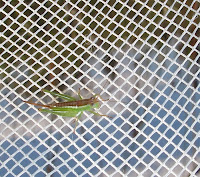Click image to enlarge
Speedy Micro Katydid - Microtettigonia tachys
As this species name suggests, these are the smallest of the Katydids from the large and highly diverse Tettigoniidae family. They can be reasonably common around fine stemmed sedge on the edge of swamps or flood plains, but due to their size are rarely seen unless accidentally caught when sweeping with a net. At first capture, thoughts turn to nymphs and with this in mind they are discarded or will themselves leap to freedom, until the tiny ovipositor is spotted to make you realise you are looking at very small adult.
The female of Microtettigonia tachys (excluding the antennae and ovipositor) is around 7 mm or just over ¼” in length, but despite their lack of size, they are excellent jumpers and are lost from view in an instant, rarely to be relocated. Because of this jumping ability, all above individuals are female (being easy to identify), but when the net is opened wide to view a possible smaller male, one jump and they are gone. I thought when producing this post that I did have one, but it turned out to be a nymph of other species, which can be tricky to separate.
These midget katydids are endemic to Australia and currently known from seven species, which are distributed over the southern portion of the country. Microtettigonia tachys is recorded from the heath coastal sand-plain from Mt Ragged to Albany. They are nocturnal and herbivorous, probably feeding on grasses, sedges and other low growing vegetation. Locally adults are found during summer and autumn.
Further reading: ‘A Guide to the Katydids of Australia’ by David Rentz.





